Abstract
The Abnormal chromosome 10 (Ab10) in maize causes normally-quiescent blocks of heterochromatin called knobs to function as meiotic centromeres. Under these circumstances genetic markers associated with knobs exhibit meiotic drive, i.e., they are preferentially transmitted to progeny. Here we describe a mutation called suppressor of meiotic drive (smd1) that partially suppresses meiotic drive, and demonstrate that smd1 causes a quantitative reduction in the mobility of knobs on the meiotic spindle. We conclude that Smd1 encodes a product that is necessary for the activation of ectopic centromeres, and that meiotic drive occurs as a consequence of the resulting change in chromosome movement. As a genetic system, Ab10 offers a new and powerful approach for analyzing centromere/kinetochore function.
Full text
PDF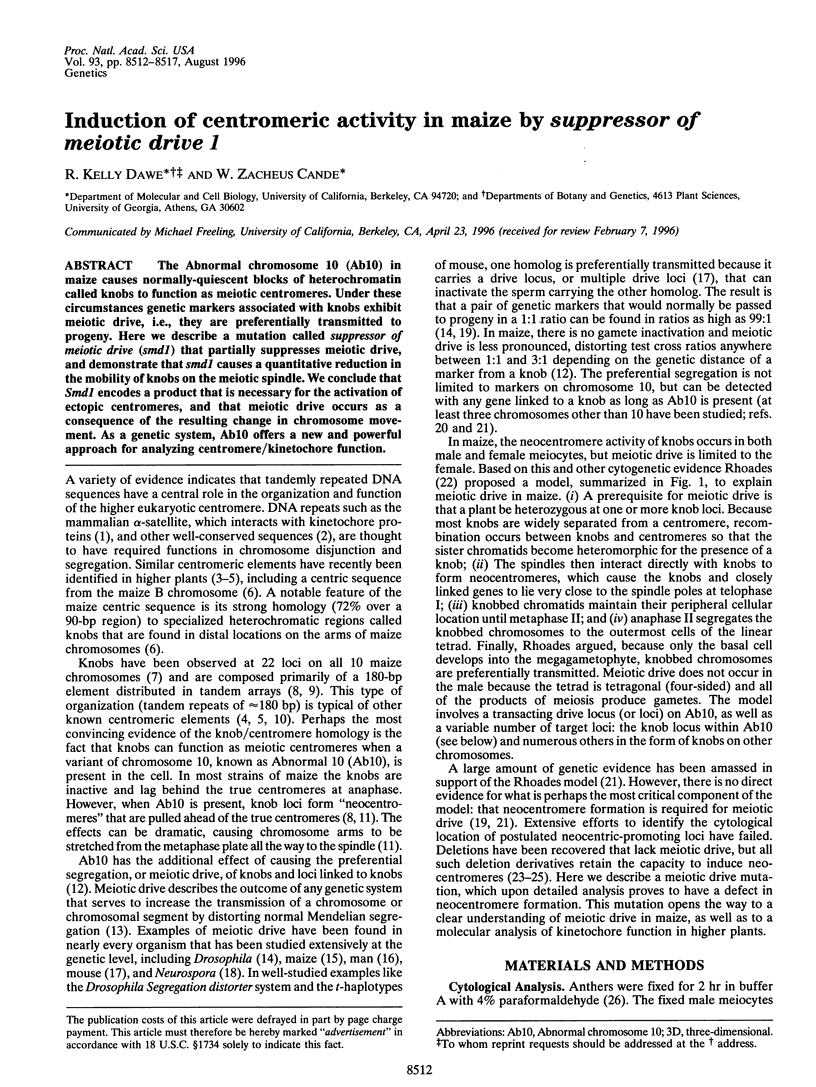
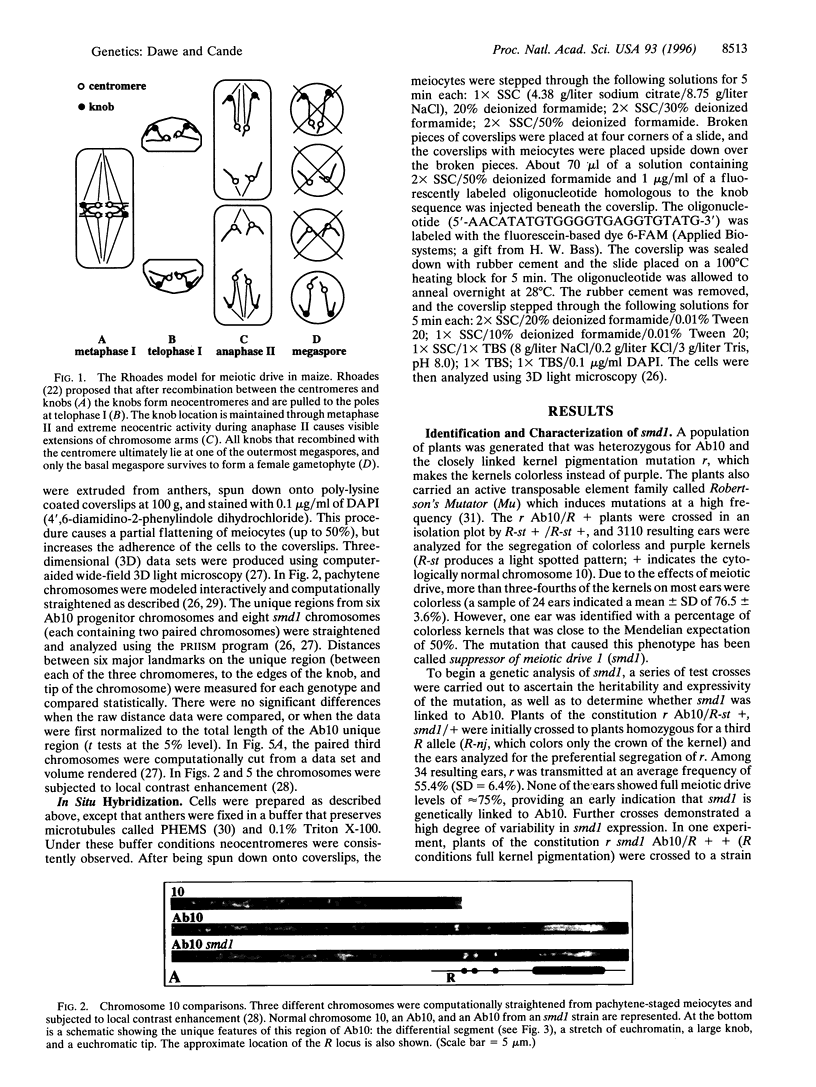

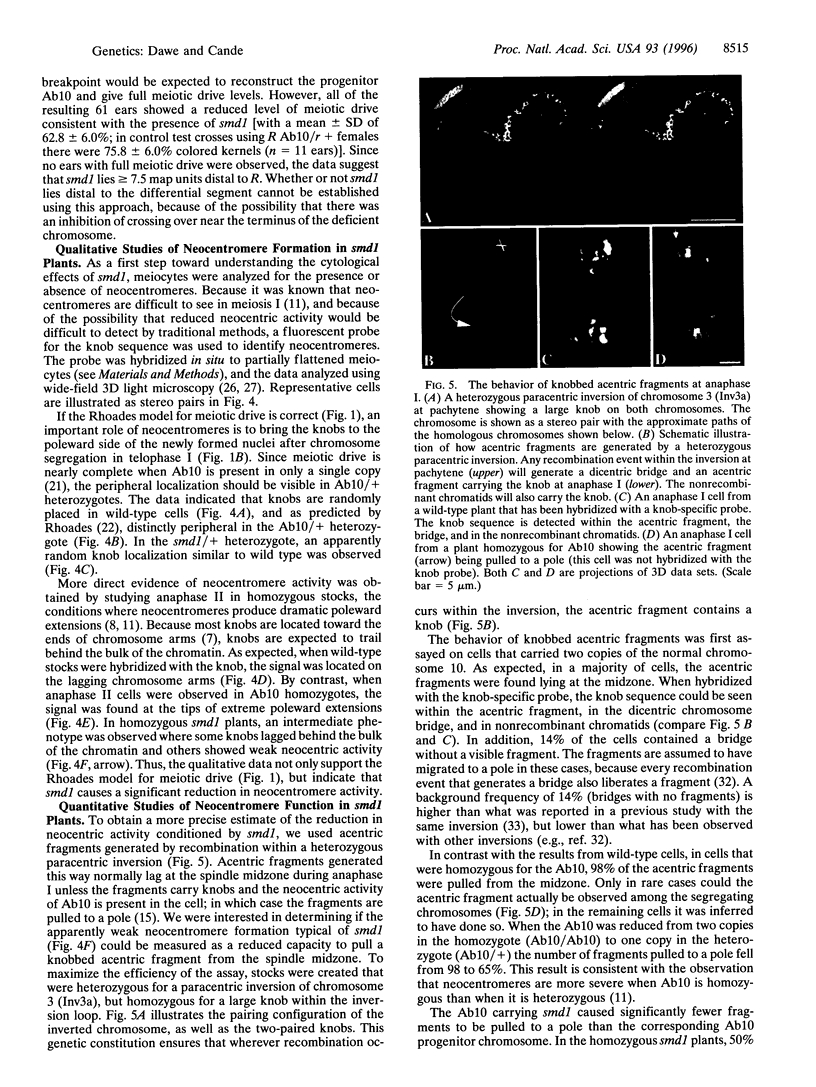
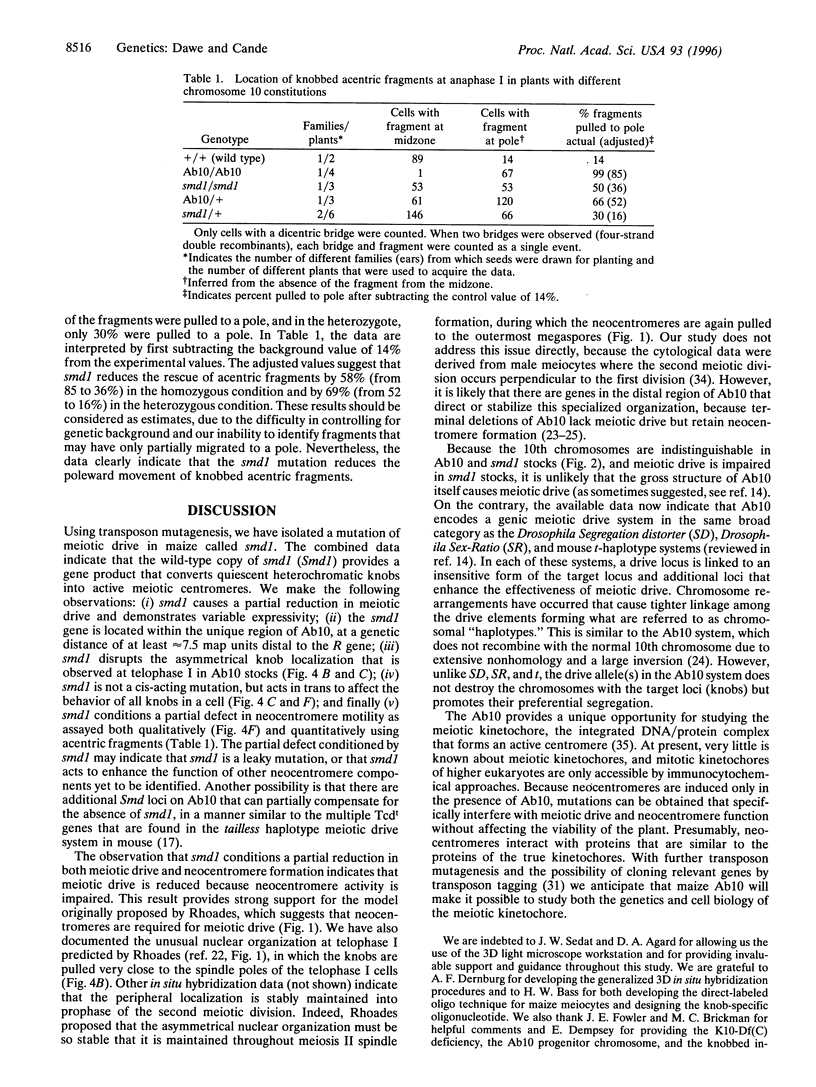
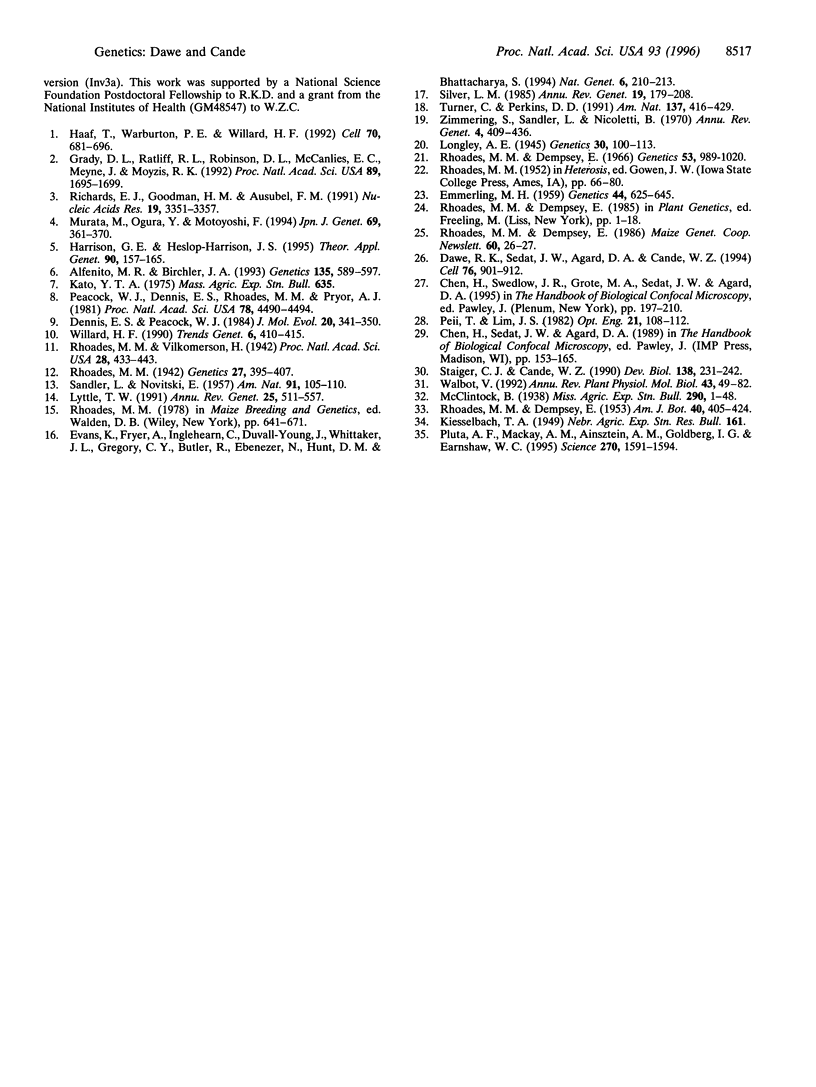
Images in this article
Selected References
These references are in PubMed. This may not be the complete list of references from this article.
- Alfenito M. R., Birchler J. A. Molecular characterization of a maize B chromosome centric sequence. Genetics. 1993 Oct;135(2):589–597. doi: 10.1093/genetics/135.2.589. [DOI] [PMC free article] [PubMed] [Google Scholar]
- Dawe R. K., Sedat J. W., Agard D. A., Cande W. Z. Meiotic chromosome pairing in maize is associated with a novel chromatin organization. Cell. 1994 Mar 11;76(5):901–912. doi: 10.1016/0092-8674(94)90364-6. [DOI] [PubMed] [Google Scholar]
- Dennis E. S., Peacock W. J. Knob heterochromatin homology in maize and its relatives. J Mol Evol. 1984;20(3-4):341–350. doi: 10.1007/BF02104740. [DOI] [PubMed] [Google Scholar]
- Emmerling M H. Preferential Segregation of Structurally Modified Chromosomes in Maize. Genetics. 1959 Jul;44(4):625–645. doi: 10.1093/genetics/44.4.625. [DOI] [PMC free article] [PubMed] [Google Scholar]
- Evans K., Fryer A., Inglehearn C., Duvall-Young J., Whittaker J. L., Gregory C. Y., Butler R., Ebenezer N., Hunt D. M., Bhattacharya S. Genetic linkage of cone-rod retinal dystrophy to chromosome 19q and evidence for segregation distortion. Nat Genet. 1994 Feb;6(2):210–213. doi: 10.1038/ng0294-210. [DOI] [PubMed] [Google Scholar]
- Grady D. L., Ratliff R. L., Robinson D. L., McCanlies E. C., Meyne J., Moyzis R. K. Highly conserved repetitive DNA sequences are present at human centromeres. Proc Natl Acad Sci U S A. 1992 Mar 1;89(5):1695–1699. doi: 10.1073/pnas.89.5.1695. [DOI] [PMC free article] [PubMed] [Google Scholar]
- Haaf T., Warburton P. E., Willard H. F. Integration of human alpha-satellite DNA into simian chromosomes: centromere protein binding and disruption of normal chromosome segregation. Cell. 1992 Aug 21;70(4):681–696. doi: 10.1016/0092-8674(92)90436-g. [DOI] [PubMed] [Google Scholar]
- Longley A E. Abnormal Segregation during Megasporogenesis in Maize. Genetics. 1945 Jan;30(1):100–113. doi: 10.1093/genetics/30.1.100. [DOI] [PMC free article] [PubMed] [Google Scholar]
- Lyttle T. W. Segregation distorters. Annu Rev Genet. 1991;25:511–557. doi: 10.1146/annurev.ge.25.120191.002455. [DOI] [PubMed] [Google Scholar]
- Murata M., Ogura Y., Motoyoshi F. Centromeric repetitive sequences in Arabidopsis thaliana. Jpn J Genet. 1994 Aug;69(4):361–370. doi: 10.1266/jjg.69.361. [DOI] [PubMed] [Google Scholar]
- Peacock W. J., Dennis E. S., Rhoades M. M., Pryor A. J. Highly repeated DNA sequence limited to knob heterochromatin in maize. Proc Natl Acad Sci U S A. 1981 Jul;78(7):4490–4494. doi: 10.1073/pnas.78.7.4490. [DOI] [PMC free article] [PubMed] [Google Scholar]
- Pluta A. F., Mackay A. M., Ainsztein A. M., Goldberg I. G., Earnshaw W. C. The centromere: hub of chromosomal activities. Science. 1995 Dec 8;270(5242):1591–1594. doi: 10.1126/science.270.5242.1591. [DOI] [PubMed] [Google Scholar]
- Rhoades M M. Preferential Segregation in Maize. Genetics. 1942 Jul;27(4):395–407. doi: 10.1093/genetics/27.4.395. [DOI] [PMC free article] [PubMed] [Google Scholar]
- Rhoades M. M., Dempsey E. The Effect of Abnormal Chromosome 10 on Preferential Segregation and Crossing over in Maize. Genetics. 1966 May;53(5):989–1020. doi: 10.1093/genetics/53.5.989. [DOI] [PMC free article] [PubMed] [Google Scholar]
- Rhoades M. M., Vilkomerson H. On the Anaphase Movement of Chromosomes. Proc Natl Acad Sci U S A. 1942 Oct;28(10):433–436. doi: 10.1073/pnas.28.10.433. [DOI] [PMC free article] [PubMed] [Google Scholar]
- Richards E. J., Goodman H. M., Ausubel F. M. The centromere region of Arabidopsis thaliana chromosome 1 contains telomere-similar sequences. Nucleic Acids Res. 1991 Jun 25;19(12):3351–3357. doi: 10.1093/nar/19.12.3351. [DOI] [PMC free article] [PubMed] [Google Scholar]
- Silver L. M. Mouse t haplotypes. Annu Rev Genet. 1985;19:179–208. doi: 10.1146/annurev.ge.19.120185.001143. [DOI] [PubMed] [Google Scholar]
- Staiger C. J., Cande W. Z. Microtubule distribution in dv, a maize meiotic mutant defective in the prophase to metaphase transition. Dev Biol. 1990 Mar;138(1):231–242. doi: 10.1016/0012-1606(90)90193-m. [DOI] [PubMed] [Google Scholar]
- Willard H. F. Centromeres of mammalian chromosomes. Trends Genet. 1990 Dec;6(12):410–416. doi: 10.1016/0168-9525(90)90302-m. [DOI] [PubMed] [Google Scholar]
- Zimmering S., Sandler L., Nicoletti B. Mechanisms of meiotic drive. Annu Rev Genet. 1970;4:409–436. doi: 10.1146/annurev.ge.04.120170.002205. [DOI] [PubMed] [Google Scholar]





